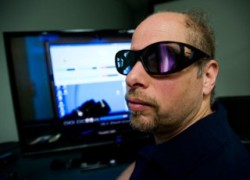Apr 30 2010
From its heyday in the 1950s to its current resurgence, 3-D technology has gone from a cinematic gimmick to a box-office gold mine.
 From its heyday in the 1950s to its current resurgence, 3-D technology has gone from a cinematic gimmick to a box-office gold mine.
From its heyday in the 1950s to its current resurgence, 3-D technology has gone from a cinematic gimmick to a box-office gold mine.
James Cameron’s Avatar, heralded for its creation of a three-dimensional fantasy world, is now the highest grossing movie ever. So it seems that audiences are keen on three-dimensional media productions, but do they really like it better than 2-D and what do they like about it? According to one Ryerson University researcher, the truth behind viewers’ perceptions of 3-D media is in their faces and eyes.
Richard Grunberg, Professor in Ryerson’s School of Radio and Television Arts, is conducting groundbreaking work on audience members’ responses to four image formats: 4K (extreme high definition), 4K 3-D, 4K 2-D and 2K 2-D (still high definition, but with lower resolution). As director of photography in the University’s state-of-the-art Digital Cinema and Advanced Visualization Laboratory, Canada’s first full 4K Digital Cinema Lab, he’s curious to know how viewers react to the technical aspects of images, including resolution, noise, compression, motion artifacts, colorimetry and dynamic range.
It’s important to study viewers’ responses, says Grunberg, given the rebirth of 3-D technology and the growing availability of 4K digital cinema. “We’re trying to analyze how people perceive the difference in formats and then quantify it. For example, do people react 20 per cent more to an image that’s shown in 4K high definition? Do they really have a greater response to 3-D images and to what degree? It’s all about making sure the producers, and the audiences, get the most bang for their buck.”
Grunberg launched his research process by shooting a children’s television show in the digital cinema lab using different image formats. A number of 3-D experts, as well as directors and directors of photography from several Canadian kids’ TV programs were invited to participate in the shoot.
With this footage now in hand, Grunberg and his team is recruiting volunteers who will watch the program while their facial and eye movements are monitored by sophisticated tracking equipment and computer software programs. The observation process has a number of goals. For example, where do audience members look during specific on-screen moments; which special effects garner the most favourable reactions; and how do different age groups respond to various image formats and screen sizes?
“We’re also trying to identify the parameters of 3-D technology,” Grunberg says. “For instance, if a 3-D hand is shown on a 42-inch screen, at what point does it become disconcerting to the viewer?”
Grunberg’s preliminary research attracted considerable attention at the 2010 National Association of Broadcasters’ show, which was held in Las Vegas in April. Ultimately, production and post-production companies could, with the help of Grunberg’s findings, custom-design 3-D films taking into account both different screen sizes and the unique preferences of certain viewer groups, such as children.
“There’s still room for improvement in 3-D technology,” said Grunberg. “We’re working to make it as much of an immersive experience as possible. At the end of the day, the goal is to maximize the audience’s viewing experience.”
The $2.9-million Digital Cinema and Advanced Visualization Laboratory, outfitted with an impressive array of technology, has received funding and support from the Canada Foundation for Innovation, the Ontario Ministry of Research and Innovation , DALSA Corporation, CANARIE (Canada’s National Research and Education network provider), and StarLight (a Global Open Light Exchange facility in Chicago).
Source: http://www.ryerson.ca/